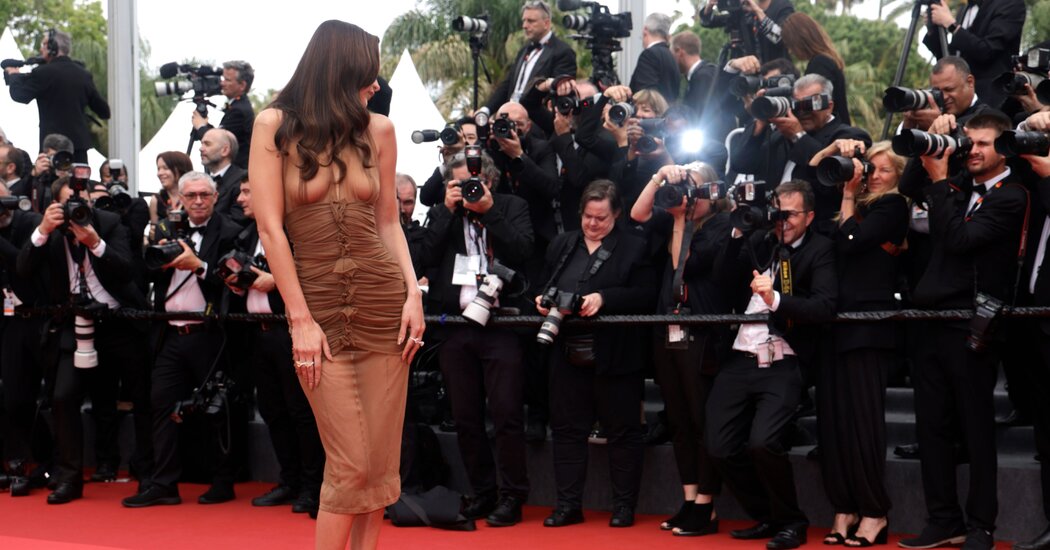The Cannes Film Festival is getting more covered-up — and just in time for the opening ceremony honoring the octogenarian Robert De Niro. Bella Hadid, newly blonde, is already in town, and stars expected include Halle Berry, Scarlett Johansson and Emma Stone. But anyone expecting one of the most reliable moves on the red carpet might be disappointed. The new dress code for gala screenings includes the admonition, “for decency reasons, nudity is prohibited on the red carpet, as well as in any other area of the festival.”
Cue a crisis in the fashion-film industrial complex.
After all, nowhere has the naked dress been more of a presence than at Cannes, where the combination of Mediterranean, sun and a certain Gallic disdain for prudishness (or at least perceived disdain for prudishness) have conspired to create its own tradition of sartorial liberation.
And “nudity,” when it comes to celebrity dressing, is a relative term. The idea that it may no longer be a shortcut to the spotlight is even more shocking than the clothing it may be proscribing.
“Naked dressing,” or that mode of dress in which large swathes of the normally private body are aired for public viewing, has been a tent pole of the publicity machine since long before Marilyn Monroe cooed ”Happy birthday, Mr. President” into a microphone in a flesh-colored sheath so tight it left little to the imagination.
In recent years it has become practically a category unto itself, especially at events like the Met Gala. That’s where Beyoncé played Venus on the half shell in 2015 in sheer Givenchy with strategically placed floral embroidery. Where, in 2024, Rita Ora wore a nude Marni bodysuit covered in what looked like strings, and Kylie Minogue modeled a Diesel dress with a naked torso superimposed on her actual torso. It has been framed as a post-Covid libidinal celebration and a post-#MeToo reclamation of the body. Either way, it is pretty much always a talking point.
All the way back in 1985, Ilona Staller, or La Cicciolina, the porn star, politician and former wife of Jeff Koons, walked the Cannes red carpet in a white satin … well, what would you call it? An evening version of Rudi Gernreich’s monokini, with breast-baring straps and a long white satin skirt. Madonna dropped her opera cape to reveal her Jean Paul Gaultier bullet bra and undies on the carpet in 1991, and in 2002 Cameron Diaz wore a sheer beaded gown and panties, starting a peekaboo trend that is still going strong.
Indeed, the dress as scrim, a transparent piece of nothing draped over bare skin or lingerie to suggest clothing without actually covering much of anything, is perhaps the most popular current form of naked dressing. It is more omnipresent than, say, the skirt slit up to here and the top cut down to there that has also been modeled by many on the red carpet. It provides the illusion of clothes while also teasing what is underneath.
It’s unclear from the wording of the Cannes dress code if the new policy applies only to literal nudity or to clothing that exposes body parts that might reasonably be termed “indecent.” According to Agnès Leroy, the head of press for the festival, the new rules were established to codify certain practices that have been long in effect. The aim, she said, “is not to regulate attire per se, but to prohibit full nudity — meaning the absence of clothing — on the red carpet, in accordance with the institutional framework of the event and French law.” (Even if French law allows toplessness on some beaches, a reality that may add to the confusion around the Cannes rules.)
Still, that leaves the dictum somewhat open to interpretation, given the general absence of fabric in many evening looks. One person’s vulgarity can be another person’s celebration, and who is to say who gets to police whose body?
(This is reminiscent of the time Melania Trump addressed critics of her naked photo shoots in her memoir, situating them in an artistic tradition that includes John Collier’s “Lady Godiva” and Michelangelo’s “David,” and noting that “we should honor our bodies and embrace the timeless tradition of using art as a powerful means of self-expression.”)
Perhaps the new code is simply calculated to prevent the sort of attention-grabbing stunt that occurred at the Grammys in February, when Ye, the rapper formerly known as Kanye West, crashed the red carpet with his wife, Bianca Censori, only to have her take off her fur coat to reveal her fully naked body “covered” by an entirely transparent nylon slip that provided no coverage at all. That seemed to have taken the trend to its ultimate, disturbing extreme by breaking the last barrier in naked dressing: genitalia.
Even though Ye had not actually been invited to the event, he and his wife dominated the headlines the next day more than the actual award ceremony.
The fact that the Cannes dress code also prohibits “voluminous outfits, in particular those with a large train, that hinder the proper flow of traffic of guests and complicate seating in the theater” suggests that what the organizers were really forestalling was the appearance of dresses that act as their own sort of performance art, grabbing eyeballs and dominating conversations that might otherwise be focused on the films that are the nominal point of the festival.
If that was the aim, however, it has somewhat backfired. By officially banning nudity on the carpet, the Cannes organizers simply sparked a raft of pieces (like this one) discussing nudity on the carpet. Most of them focus less on the actual meaning of the term in all its thorny nuance than the opportunity to revisit notorious nude-adjacent moments past.
You could have seen that one coming.











